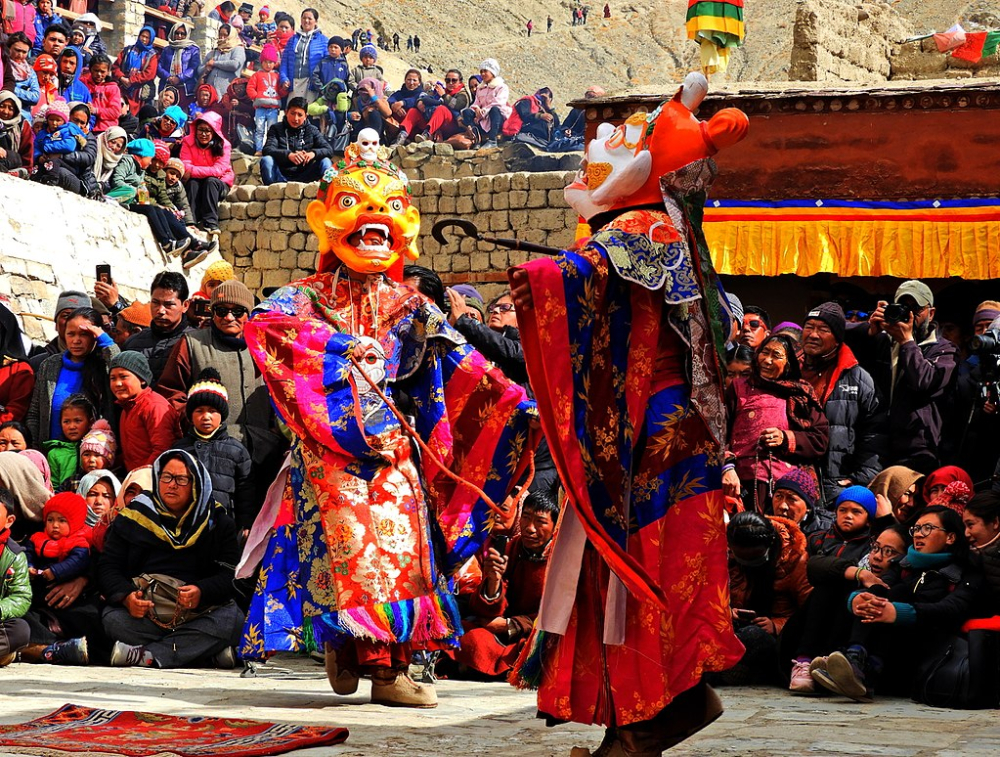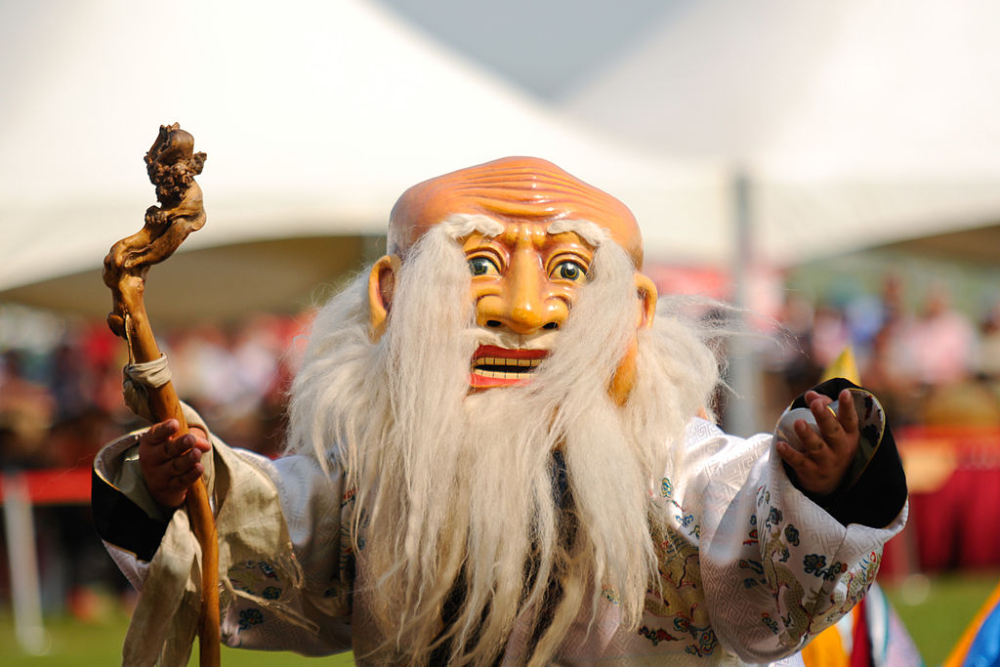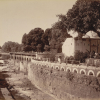Cham is a vibrant Buddhist dance performed by and associated with a number of Tibetan Buddhist sects. A common feature during occasions such as the Hemis festival, there are different kinds of chams, each with a backstory and a legend. We look at five chams—the skeleton dance (durdak garcham), the deer dance (sha cham), the black hat dance (zhana nga cham), the old white man from Mongolia, and the Tibetan meditative dance (gar cham)—that are performed in various Buddhist monasteries across India, Tibet and Nepal on different occasions. (Photo Courtesy: Zazaa Mongolia [CC BY-SA 4.0])
The Hemis gompa (monastery) is one of the most important and wealthiest monasteries in Ladakh. Founded in the 17th century by Stagsan Raspa, the gompa is closely associated with the royal family of Ladakh. Each year, usually in July, the Hemis festival that was started by Gyalsras Rinpoche in the 18th century, is celebrated at the monastery, and is a huge event, attracting people from all over the world.[1] In ‘The Cham of Padmasambhava in the Monastery of Hemis (Ladakh),’ Mireille Helffer writes that it is celebrated on ‘the 10th day (tshe-bcu) of the fifth month of the Tibetan calendar in honour of [Guru] Padmasambhava’.[2] One of the highlights of the festival is the cham performance—an enigmatic and energetic mask dance. Cham is used in all four schools of Tibetan Buddhism—Nyingma, Sakya, Kagyu and Gelug—in their rituals as a sacred dance that is reflective of the Buddhist tantric practices.
In Tibetan Sacred Dance: A Journey into the Religious and Folk Traditions, a scholar of Buddhism Ellen Pearlman notes, ‘it was the Nyingma school that first established the Cham in Tibet, and that they had many different dances derived from visionary dreaming.’[3] As the rituals spread across the region, variations of cham evolved at different monasteries. ‘There were various chams and commemorative dances which celebrated the birth of Tsongkhapa [a Buddhist teacher from the Amdo province of eastern Tibet who set up the Ganden, Sera and Drepung monasteries and was the uncle of the First Dalai Lama] and others which re-enacted historical events.’[4]
Though after the Chinese invasion of Tibet in the 1950s, much of the cham literature were destroyed, records of some of the variations of the dance have survived. Scholars have studied these records and documented ongoing practices in monasteries, especially during occasions such as the Hemis festival to further their knowledge. It is on the basis of such research that these variations in cham have been written about, and here we look at five— the skeleton dance (durdak garcham), the deer dance (sha cham), the black hat dance (zhana nga cham), the old white man from Mongolia, and the Tibetan meditative dance (gar cham)—that are performed in various Buddhist monasteries across India, Tibet and Nepal.
Skeleton Dance

The skeleton dancers, also known as citipati or chitipati, originated from the legend of the citipati, who were the members of the vajrakilaya cham that was started by Guru Padmasambhava at Samye monastery (Courtesy: Wonderlane [CC BY 2.0])
The skeleton dancers, also known as citipati or chitipati, originated from the legend of the citipati, who were the members of the vajrakilaya cham that was started by Guru Padmasambhava at Samye monastery—the first monastery in Tibet—in the 8th century. It is believed that the citipati were protector skeletal deities who performed this dance. It is now performed—wearing masks and overalls that look like skeletons—at monasteries to commemorate them. According to Pearlman, the skeletons ‘represent the disintegration of phenomena, including the body itself as well as the impermanent nature of various states of mind.’[5]
Deer Dance

The deer/stag dance, called Milarepa cham, stems from the legend of the 11th-century Buddhist mystic Jetsun Milarepa, who tamed a dog in order to protect a deer that had entered his cave (Courtesy: Sumita Roy Dutta [CC BY-SA 4.0])
The deer/stag dance, called Milarepa cham, stems from the legend of the 11th-century Buddhist mystic Jetsun Milarepa, who tamed a dog in order to protect a deer that had entered his cave. The dance is believed to have originated at Tser Gontham, a Kagyu monastery by the Lhasa river in Tibet. The deer dance can be interpreted in different ways depending on the performance. If it is performed by a group, the dancers signify and represent ‘one of the many protector deities’ and rids the new year of the negative forces. But when it is performed by one dancer, he represents the deer that was tamed and rescued by Milarepa.[6]
The Black Hat Dance

The black hat dance, or zhana nga cham, is connected with the origins of tantra and played a significant role in the establishment of Buddhism in Tibet (Courtesy: Stephen Shephard [CC BY-SA 3.0])
The black hat dance, or zhana nga cham, is associated with the legend of the ruthless Tibetan king, Langdarma, who destroyed numerous monasteries and executed Buddhist nuns and monks. It is believed that a Buddhist monk by the name of Lhalung Pelgyi Dorje performed a cham in front of the king before striking him with an arrow. The performers wear a robe called phod-ka, and a long, black apron embroidered with ‘a border of skulls’. In her essay ‘A Black Hat Ritual Dance’, Cathy Cantwell quotes the fifth Dalai Lama, Ngawang Lobsang Gyatso, who said that the dance ‘derives from Indian Buddhism... it is connected with the origins of the Tantra, and that moreover, it played a significant role in the establishment of Buddhism in Tibet: Guru Padma performed the dance to prepare the ground at bSam-yas [Samye] for the first Tibetan monastery.’[7]
The Old White Man from Mongolia


It is the only dance in which the performer is allowed to speak, and it is believed that the dance is derived from a dream that the 13th Dalai Lama, Thubten Gyatso, had when he fled from Tibet to Mongolia in 1904 (Courtesy: Zazaa Mongolia [CC BY-SA 4.0])
The dance of the old white man, Tsagan Evgen[8], is perhaps one of the most recent additions in the 800-year-old history of Tibetan dances. It is the only dance in which the performer is allowed to speak, and it is believed that the dance is derived from a dream that the 13th Dalai Lama, Thubten Gyatso, had when he fled from Tibet to Mongolia in 1904. During the performance, the dancer wears a white gown and holds a walking stick in his hands.
Gar Cham

The dance, compared to other chams, is more tranquil and primarily consists of hand movements, while the other chams are ‘more wrathful and energetic, concentrating more on footwork (Courtesy: Sumita Roy Dutta [CC BY-SA 4.0]
The gar is perhaps one of the few dances that are performed in secret by the lamas. Though it is a type of cham, it is not for public viewing. The dance, compared to other chams, is more tranquil and primarily consists of hand movements, while the other chams are ‘more wrathful and energetic, concentrating more on footwork. The Fifth Dalai Lama, speaking of the dance had said, that “when chiefly the hands move, this is called Gar, and when mainly the feet move this is known as chams”.’[9]
This article was also published by The Statesman.
Notes
[1] Sanjay Dhar, ‘Hemis Monastery,’ Sahapedia, October 11, 2018, accessed July 15, 2019, https://www.sahapedia.org/hemis-monastery.
[2] Mireille Helffer, ‘The 'cham of Padmasambhava in the Monastery of Hemis (Ladakh),’ The World of Music 22, no. 1 (1980): 107–24, accessed July 15, 2019, http://www.jstor.org/stable/43560655.
[3] Ellen Pearlman, Tibetan Sacred Dance: A Journey into the Religious and Folk Traditions (Rochester: Inner Traditions, 2002), 35.
[4] Ibid.
[5] Ibid.
[6] Ibid.
[7] Cathy Cantwell, ‘A Black Hat Ritual Dance,’ Digital Himalaya, 1992, accessed July 12, 2019, http://himalaya.socanth.cam.ac.uk/collections/journals/bot/pdf/bot_1992_01_02.pdf.
[8] There are many variations of this spelling.
[9] Ellen Pearlman, Tibetan Sacred Dance: A Journey into the Religious and Folk Traditions (Rochester: Inner Traditions, 2002), 35.












